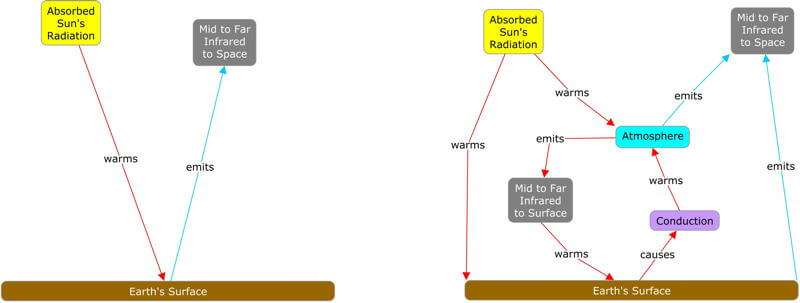Atmospheric Energy Budget
Recall from the Radiation section that objects with a temperature above absolute zero (0K) emit a broad spectrum of electromagnetic radiation (thermal radiation). The total energy given off is proportional to its temperature to the fourth power. A small change in temperature has a considerable impact on the amount of radiation emitted by an object. Also, the hotter the object, the radiation shifts to shorter wavelengths. So the Sun’s surface is quite hot, and its spectrum ranges mostly between ultraviolet to near-infrared (NIR). Earth surfaces warmed by sunlight emit radiation in the mid to far-infrared (FIR).

Concept maps of a planet’s energy budget for two scenarios. On the left is a planet without an atmosphere, and on the right is a planet with an atmosphere without greenhouse gases.
Absorbed solar radiation warms the planet’s surface, which in turn radiates more thermal radiation away from the surface. The surface temperature stops changing when the rate of energy gained from the solar radiation equals the rate of thermal radiation emitted. This scenario creates a scorching surface, such as the moon’s maximum temperatures of 260ºF (127ºC). Nighttime creates frigid temperatures as the outgoing thermal radiation continually cools the surface. The moon’s surface falls to –280ºF (-173ºC) during its 14.25 Earth-day long night.
When a planet has an atmosphere, the solar radiation absorbed by the atmosphere warms the gases in the atmosphere. The absorbed solar radiation heats the surface, which in turn warms the air near the ground through conduction. The warmed air rises, and cooler air replaces it. The conduction also cools the planet’s surface, so there is less thermal radiation emitted. The warmer atmosphere emits more thermal radiation, roughly half travels back to the planet’s surface, and half goes to space. The surface absorbs the thermal radiation emitted from the atmosphere, which adds to warming the atmosphere through conduction.
If water isn’t present, this planet’s surface has three ways to cool: conduction, convection, and thermal radiation. Recall that convection increases the rate of conduction. The amount of energy coming into the planet equals the amount of radiation leaving the planet. An atmosphere stores heat in its gases. All other factors being equal, the surface of a planet with an atmosphere will be cooler during the day and warmer during the night than a surface without an atmosphere. The heat exchanged with the atmosphere delays the heating during the day and the cooling at night.

0 Comments